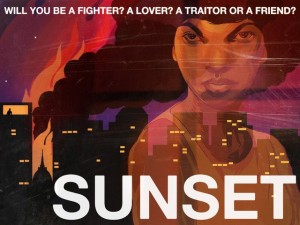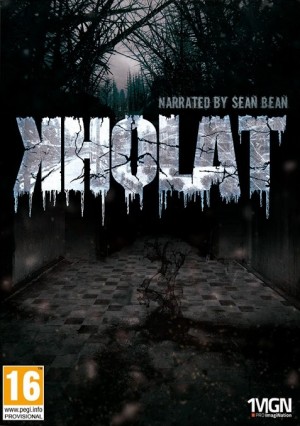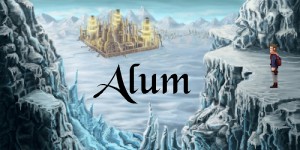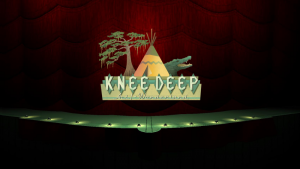Review for Until Dawn
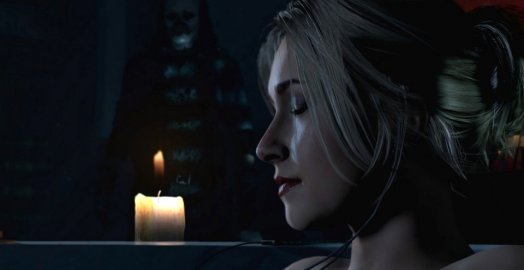
Here’s the best way to play Until Dawn: On Friday or Saturday night, get a few friends together, preferably with a few beers, and marathon your way through it, passing the controller off whenever the game switches characters. When the game presents a branching path, tally up votes based on the scientifically infallible method of Everyone Shouting At The Same Time. “Risk the shortcut!” versus “No, take the long way, play it safe!” Whichever choice elicits the most volume wins, though the person in control can always veto if they feel strongly enough. Talking over the game should be encouraged, especially yelling at the characters for doing stupid things and shrieking when the game throws you into Quick Time Event-heavy life-or-death situations. And when someone dies, make sure to relentlessly shame whoever was holding the controller.
This game can certainly be enjoyed alone, but the schlocky, cliché-ridden world of teen slasher horror is often a great social experience. Slasher movies are the fun kind of horror, the kind that’s as funny as it is scary, the kind that revels in ridiculous, fake-looking gore and unrealistic situations. These are the movies that give awkward teen couples an excuse to clutch each other’s arms and get real close in the theaters. They’re dumb, and the best ones are smart in how dumb they are.
Until Dawn nails that smart dumbness, that very tricky balance between grave self-seriousness and knowing winks to the audience. It’s not even a loving homage to slasher flicks – it just IS one, wrapped in a clever mix of Heavy Rain-style branching narrative and survival horror gameplay. Developed by Supermassive Games, it’s a PS4-exclusive third-person interactive movie, having evolved a long way from its origins as a first-person PS Move motion control game for PS3. It’s not a game full of mechanical depth, nor is it a masterful narrative experience. But Until Dawn knows exactly what it is and does an excellent job of being just that.
A group of teens gather at a remote cabin a year after the mysterious deaths of two of their friends on the very same mountain. Ostensibly, they are gathering to commemorate the anniversary of their friends’ passing – by getting wasted and having lots of awkward teen hanky-panky. There’s Josh, the brother of the two dead girls who is adamant that he’s “over it” and just wants to have a good time; Sam, the “good girl” who chides the others and is definitely into Crossfit; Mike, the handsome jokester, who may or may not be cheating on his new girlfriend, the loud and proud blonde Jess; Emily, Mike’s narcissistic ex, who is now dating the almost-too-nice jock with a heart of gold Matt; and finally Chris and Ashley, the quippy, cynical hipsters who are desperately into each other but too shy to admit it.
Shortly after arriving, the teens settle into their usual routine of gossiping, making out, and talking about how much they love to party. This lasts just long enough to set up some love triangles, rivalries, and friendships. Then, shocker! A psycho killer starts stalking, taunting, and hunting them, one by one. It’s not long before the teens are split up around the mountain vying for their lives, from the killer as well the treacherous environment. On top of all this is a framing narrative of a mystery patient being interviewed by a fourth wall-breaking psychiatrist who loves to ask strange and dramatic questions like “Which do you fear more? Spiders or Snakes?” or “Which of the characters in this game do you like least?” Your answers to these questions may have strange and unforeseeable effects on how events play out.
The cast is pretty much perfect – not because they are great actors, but because they are just the right kind of C-List actors that would be cast in a true slasher movie. There are some immediately recognizable faces: Hayden Panettiere (Heroes, Nashville) plays Sam, and Peter Stormare (Fargo, Armageddon, and a million weird bit parts) is impeccably awkward and creepy as the world’s worst psychiatrist. Others look familiar in that way that perennial television character actors do – Rami Malek of The Pacific and Mr. Robot, Noah Fleiss of dozens of supporting roles, Meaghan Martin of the Disney Channel and ABC Family stable of talent, and so on. These actors contributed their voices as well as facial performance and motion capture. While the technology doesn’t always manage to leap the uncanny valley, the cast does a great job establishing the earnest hamminess of your classic slasher fare.
For the most part, the presentation is fantastic. Until Dawn looks and feels like a mid-tier horror movie, from the oppressively dark lighting to the overbearing musical stingers that blast over the game’s copious jump scares. The character models are incredibly detailed, and in still shots are some of the best 3D recreations of real people I’ve seen in a game. In motion, their facial expressions don’t always keep up the illusion; characters occasionally have a bug-eyed, slack-jawed look when trying to emote, but most of the time it’s quite good, with each person giving a distinctive performance that overcomes the limitations of the tech. The environments are uniformly dark – almost too dark – but are still very impressive. Whether it’s a forest path in the mountain or a luxurious cabin bedroom, each location is dense with convincing details and expressive lighting. All this gorgeous detail comes at the cost of a stable frame rate, unfortunately, which seems to hover under 30 FPS for much of the game and occasionally dips into the teens. It doesn’t impact the game’s playability, but it does detract from an otherwise excellent visual presentation.
As the game progresses and the characters split up, control switches from person to person as the narrative shifts focus to catch up with them all. You’ll play as each of the characters at least once as the night progresses, generally switching every 20-30 minutes, often right after a very dramatic cut-to-black from another character’s perspective. There are no functional differences between the characters; the controls are pretty minimal as it stands. Left stick to move, right stick to direct your flashlight or other light source (if you have one). You move through the environment with tank-style controls not unlike old school survival horror games. While this can be occasionally cumbersome, you only have direct control over the characters during slower-paced exploratory segments. Small glints of light hint at objects in the environment you can use or examine. After a simple button press, you’ll either get a bit of dialogue, the opportunity to examine the object up close and rotate it around, or you’ll interact with it. It’s not always clear which, though, and there are multiple frustrating cases where prompts lead to irreversible actions such as dropping off a ledge or otherwise blocking off the option to backtrack.
In the vein of Quantic Dream’s and Telltale’s more recent games, a lot of the interaction in Until Dawn takes the form of onscreen button prompts and stick motions that mimic the real-world interaction. To flip the pages in a book, you’ll swipe along the Dualshock 4’s touch pad. To open a drawer, you’ll hold R2 to grip the handle and move the right-stick down to pull it open. When things heat up, the game will often put time limits on interactions, forcing you to act quickly or fail. Usually these limits are pretty generous, but occasionally you’ll only get a second or so, which would be annoying if it wasn’t clear that the game wants you to fail at these moments.
When you are presented with a binary choice – to respond angrily or calmly, for example, or to go back for the phone you dropped or just keep running – these choices are presented as bubbles on the left and right side of the screen (with or without optional percentages downloaded from a central server showing how many people have gone with either choice). To make a choice, you simply tilt the stick in that direction until the bubble fills up. It’s all very intuitive, and it needs to be so that making a choice is easy when you’re deciding which hallway to run down with a psycho killer breathing down your (possibly soon-to-be-severed) neck.
There are also occasional moments that prompt you to aim a cursor over a target within a short time limit – usually when you’re trying to attack something coming at you. It’s not too big of a deal normally, as the targets are generally pretty big and the time limit fairly generous, but when missing a shot could potentially mean your permanent doom, the simple act of aiming a cursor can get really intense. Not to mention the game sometimes decides it’s going to mess with you by throwing up an incredibly tiny target or giving you very little time to react.
Your choices and actions carry consequences ranging from almost insignificant to literal life-and-death. Cause and effect are not always clear, which could have been frustrating but instead manages to make every choice a nail-biter. Sure, tripping while running away from the killer might seem bad, but it’s not necessarily certain death, whereas a simple decision like who gets to hold onto a flare gun can dramatically change the fate of characters. It works because the game relies on the “butterfly effect” theme, the idea that small actions can lead to unknowable major consequences, and because the often gruesome consequences of bad choices are a twisted sort of reward in their own right.
The game autosaves constantly in the background, meaning you save hoarders can’t jump back to a previous saved game to undo your horrible, horrible mistakes. The finality of consequences in the game adds a layer of tension that cannot be overstated. In most horror games, when you screw up and get caught by the monster, you jump, shout, and are quickly reloaded to the last checkpoint. Until Dawn just keeps trucking along, rubbing your face in your failures during its frequent TV-style “Previously On…” sequences that run at the beginning of each chapter.
The entire game isn’t running for your life, thankfully. A good portion of your time will be spent exploring creepy locations with only a flashlight or torch, combing for clues and useful items. These sequences lean more toward Until Dawn’s survival horror influences, featuring dramatic, voyeuristic camera angles and slow-burning tension much like Silent Hill or Resident Evil, minus the combat. They even kept the clunky movement controls, which will have you bashing into doorways and angling to try to get in the right position to interact with an object. Thankfully, the game never asks you to perform time-sensitive actions using these controls.
As you explore, the game explicitly tracks found clues; pick up a photograph on a dresser or find a stubbed-out cigar butt in a weird location and the game will pop up a ‘Clue Discovered!’ message. I’ve always been a fan of games that allow you to examine notes, photos, and other objects in-world (as opposed to displaying the text in pop-up window), and Until Dawn is a treasure trove of that kind of thing.
A series of menus allow you to go back and examine found clues, piecing together some of the mysteries in the backstory. As you uncover more information, old clues are updated with the new details. Some of them might even turn out to be red herrings. Discovering clues doesn’t just give the player information, it also affects the characters’ knowledge of the events unfolding around them. While this often manifests as a few extra lines of dialogue during certain scenes, some clues seem to significantly alter certain aspects of the story. The tale will play out whether you uncover the mystery or not, reaching basically the same end point either way, but if you do investigate thoroughly, both you and the characters will have a greater understanding of the backstory and context for the killings.
The game also tracks stats for each of the characters, both personality traits and their relationships with others. Things like honesty, bravery, and romanticism scale up or down based on your choices, as well as the current player character’s affection for the rest of the cast. These stats are fun to check out but generally don’t reveal anything you don’t already know from seeing the characters interact.
The story may not break any new ground, but as far as teen slasher fare goes it is better than average. Along with the trademark terrible decision making, awkward flirting, and snark-filled banter between the group, there is also a solid amount of character development. You’ll waver between hating and loving just about everyone as the sense of dread peels away their affectations and reveals different sides of their personalities. While the game initially seems to be a grab bag of horror clichés, the way the various threads of the plot come together is far cleverer than I initially expected. Each path through the story feels definitive and coherent, which is a major accomplishment considering the game can end with either everyone alive, everyone dead, or just about any permutation in between.
Replaying the game pretty quickly reveals which parts are not quite as malleable as you might have thought, while others change in ways you hadn’t expected. This is still a relatively linear story with character actions and sequences that need to play out – it’s not as if anyone can die at any time. But critically, during your first playthrough it feels that way. As such, throughout the game’s eight or nine hour duration, every choice seems important. Do I take the shot or just try to run and save my only bullet for later? Take the left path or right? Do I reassure Chris or shame him for freaking out? Do I lock this door to prevent someone from following me, or leave it unlatched in case I need to make a quick escape?
That uncertainty lends weight to what might otherwise be a decent but dull exercise in slasher flick familiarity. Instead, Until Dawn feels uniquely engrossing as you laugh and scream your way to its grisly conclusion. Sharp writing, great atmosphere, and clever branching plot paths elevate the game to arguably one of the most successful attempts at an interactive movie experience to date. It’s also, like I said, an amazing party game. So get some friends together – even ones who don’t normally have any interest in games – pass around the controller, and settle in for a memorable night of watching teenagers flirt badly and die horrible deaths.











